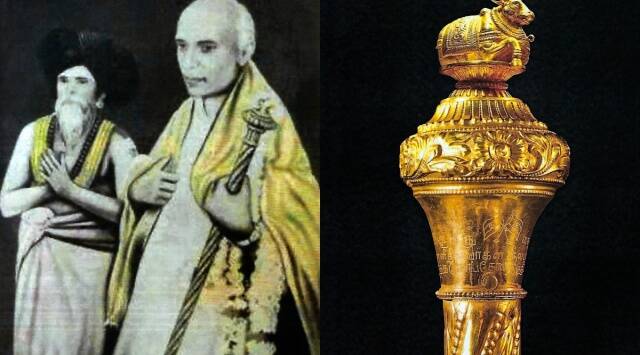Important for
Prelims: Social Issues
Mains: General Studies Paper I
Sengol
- Prime Minister Narendra Modi will install the ‘Sengol’, a historical sceptre from Tamil Nadu, in the new Parliament building.
NEWS: At new Parliament inauguration, PM to be handed over sceptre given to Nehru on eve of Independence

About
- The ‘Sengol’ was received by Independent India’s first Prime Minister, Jawaharlal Nehru, from Lord Mountbatten
- to symbolically represent the transfer of power from the British and was later kept in a museum in Allahabad.
- It was freedom fighter Rajaji (C. Rajagopalachari) who suggested to Nehru the ceremonial gesture, a tradition found to have been documented even in the Chola-era as a symbol of the transfer of power to a new king.
What is the “sengol” sceptre?
- The “sengol” sceptre is a long, stick-like item ( 5 feet) made of silver and covered in gold. The sceptre has a carving of a bull, called a Nandi, at the top. This is done to remind everyone about the importance of fair and just leadership in the country.
- ‘Sengol’ is derived from the Tamil word ‘semmai,’ which means ‘full of wealth’, the ‘Sengol’ represents the embodiment of power and authority.
- The Sengol sceptre was presented to PM Nehru by Thiruvavaduthurai Adheenam (a 500-year-old Saivaite monastery) on August 14, 1947.
- A golden sceptre was crafted by Vummidi Bangaru Chetty, a famous jeweller in Madras (now Chennai).
- After receiving the Sengol sceptre in 1947, Nehru kept it at his residence in Delhi for some time.
- He then decided to donate it to Anand Bhavan Museum in Allahabad (now Prayagraj), his ancestral home.
- The museum was established by his father Motilal Nehru in 1930 to preserve the history and legacy of India’s freedom movement.
- The Sengol sceptre remained at Anand Bhavan Museum for over seven decades.
- In 2021-22, when the Central Vista redevelopment project was underway, the government decided to revive this historical event and install the Sengol sceptre in the new Parliament building.
- It will be placed near the Speaker’s seat in the new Parliament building and will be accompanied by a plaque that will explain its history and meaning.
Traditional Chola practice
- It was a traditional Chola practice for Samayacharyas (spiritual leaders) to lead the coronation of kings and sanctify the transfer of power, which is also considered a kind of recognition for the ruler.
- Following the Chola era tradition, the pontiff of the Thiruvavaduthurai Aadeenam presented the Sengol to the first Nehru signifying the transfer of power from the British to Indian hands.
Significance
- The inclusion of the ‘Sengol’ in the Parliament building inauguration seeks to revive this ancient tradition and commemorate India’s independence as the nation enters a new chapter in its democratic journey
Practice Questions for Prelims
Mains Practice Question




Leave a Reply
You must be logged in to post a comment.